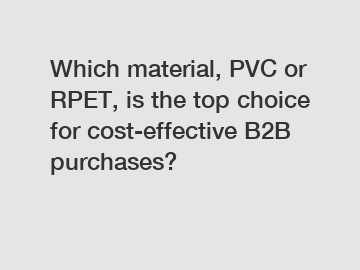Which material, PVC or RPET, is the top choice for cost-effective B2B purchases?
Which material, PVC or RPET, is the top choice for cost-effective B2B purchases? This is a common question for businesses looking for packaging materials. In this article, we will explore the differences between PVC and RPET, analyze their various factors, and finally provide an informed answer based on cost-effectiveness, durability, and environmental impact.
## Understanding PVC and RPET.
### PVC (Polyvinyl Chloride).

PVC is a popular material known for its versatility, affordability, and durability. It is widely used in many industries, including packaging, construction, and healthcare. PVC offers excellent resistance to chemicals, moisture, and impact, making it ideal for various applications. In addition, its low cost makes it an attractive option for businesses on a budget.
### RPET (Recycled Polyethylene Terephthalate).
RPET is a form of polyester made from recycled plastic bottles and containers. It is considered a more sustainable alternative to traditional plastics as it utilizes post-consumer waste as its raw material. RPET also offers similar characteristics to PVC in terms of durability and resistance to moisture. However, its production process requires less energy and emits fewer greenhouse gases, making it a more environmentally friendly choice.
## Evaluating Cost-Effectiveness.
When it comes to cost-effectiveness, there are several factors to consider.
### 1. Raw Material Cost.
PVC is generally cheaper than RPET due to its wider availability and lower production costs. This makes it a favorable choice for businesses looking to minimize expenses.
### 2. Life-cycle Cost.
While PVC may have a lower initial cost, it is important to consider the overall life-cycle cost. RPET, being a recycled material, has a smaller carbon footprint and can contribute to a company's sustainability goals. Moreover, RPET's durability ensures that packaging made from this material has a longer lifespan, reducing the need for frequent replacements.
### 3. Market Demand and Perception.
The increasing global focus on sustainability has led to a rise in consumer demand for eco-friendly products and packaging. By choosing RPET, businesses can cater to this growing market segment and improve their brand image.
## Conclusion.
After considering the factors mentioned above, RPET emerges as the top choice for cost-effective B2B purchases. While PVC may have a lower raw material cost, RPET's lower life-cycle cost, environmental advantages, and market perception make it an overall better choice. By opting for RPET, businesses can save costs in the long run, align themselves with sustainable practices, and appeal to eco-conscious consumers.
In summary, the decision between PVC and RPET ultimately depends on the specific needs and goals of a business. However, considering the advantages of RPET in terms of cost-effectiveness, durability, and environmental impact, it is clear that RPET is the preferred material for B2B purchases seeking long-term value and sustainability.
If you are looking for more details, kindly visit rPET pellets, rPET pellets, rPET pellets.


